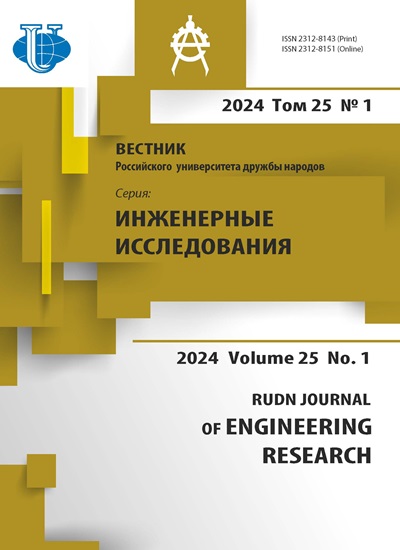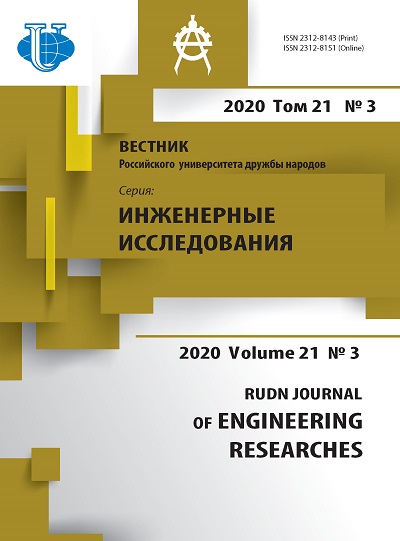Capacity of roller mill for cement grinding
- Authors: Kalyagina N.V.1, Karpukhin I.I.2, Kornilova A.V.3, Silverstov I.N.2
-
Affiliations:
- Bauman Moscow State Technical University (National Research University of Technology)
- ZAO «Prochnost»
- Peoples’ Friendship University of Russia (RUDN University)
- Issue: Vol 21, No 3 (2020)
- Pages: 181-188
- Section: Mechanical engineering and machine science
- URL: https://journals.rudn.ru/engineering-researches/article/view/25558
- DOI: https://doi.org/10.22363/2312-8143-2020-21-3-181-188
Cite item
Full Text
Abstract
Engineering for the cement industry is part of the heavy industry. The cement industry is the main supplier of raw materials for the production of concrete and reinforced concrete. For grinding cement, two types of mills are used - ball and roller. Recent decades have proven the great effectiveness of a vertical roller mill for grinding raw materials. Its effectiveness, combined with the implementation of drying, grinding and separation in one unit, gives it an undeniable advantage over a ball mill. This explains the significant increase in the share of roller mills in the cement mill market. The grinding process in such mills occurs due to abrasion, respectively, in the process of work wear of the rubbing parts of the mill occurs. The work evaluated the performance of a mill with smooth disk rolls. During the study, the cause of the destruction of the sectors of the mill produced by FLSmidth, operating in the Russian Federation, was identified. The study revealed the causes of the destruction of the details of the roller mill: with the simultaneous impact of the workload and the displacement of the sectors resulting from intensive wear, the total equivalent stresses exceed the value of the endurance limit under cyclic loading. Therefore, the accumulation of fatigue damage to the material, the formation and growth of cracks, which adversely affects the performance of the mill. A number of measures have been proposed to increase the operability of mills of this design.
Keywords
About the authors
Nadezhda V. Kalyagina
Bauman Moscow State Technical University (National Research University of Technology)
Author for correspondence.
Email: kornilova-av@rudn.ru
Associate Professor of Department of Applied Mechanics of Faculty of Robotics and Complex Automation of BMSTU; Candidate of Physico-Mathematical Sciences, PhD
5 2-ya Baumanskaya, bldg 1, Moscow, 105005, Russian FederationIvan I. Karpukhin
ZAO «Prochnost»
Email: kornilova-av@rudn.ru
CEO
8а Ryazanskii Ave, Moscow, 109428, Russian FederationAnna V. Kornilova
Peoples’ Friendship University of Russia (RUDN University)
Email: kornilova-av@rudn.ru
Professor of the Construction Department of the Academy of Engineering of RUDN University; Doctor of Technical Sciences
6 Miklukho-Maklaya St, Moscow, 117198, Russian FederationIgor N. Silverstov
ZAO «Prochnost»
Email: kornilova-av@rudn.ru
chief engineer; Candidate of Technical Sciences
8а Ryazanskii Ave, Moscow, 109428, Russian FederationReferences
- Brozek M, Naziemiec Z. Analysis of the mechanics of the comminution process of minerals in crushers and high-pressure grinding rolls. Gospodarka surowcami mineralnymi [Mineral resources management]. 2012;28(3):139-153.
- Simmons M, Gorby L, Terembula J. Operational experience from the United States' first vertical roller mill for cement grinding. 2005 IEEE. Cement Industry Technical Conference. Conference Record. 2005. p. 241-249.
- Altun D, Aydoğan N, Altun O, Benzer A. Performance Evaluation of Vertical Roller Mill in Cement Grinding: Case Study ESCH Cement Plant. European symposium on comminution classification. Conference Paper 15. 2017. p. 1-7.
- Engeln I. Polysius roller mills for cement grinding - operating results from a Maxican cement works. 35th Krupp Polysius Cement Day. Conference Paper. ZKG International. 2001;54(10):550-554.
- Saito J, Hosono M, Shibuya K, Okano Y. Roller Mill as a Control Object. IFAC Proceedings. 1983;16(15):91-99.
- Jung O. Wear protection in vertical roller mills. ZKG International. 2000;31(9):252-261.
- Zenkevich O. Metod konechnykh elementov v tekhnike [Finite element method in engineering]. Moscow: Mir Publ.; 1975. (In Russ.)
- Zavarise G, Wriggers P, Schrefler B. A method for solving contact problems. International Journal for Numerical Methods in Engineering. 1998;42(3):473-498.
- Kuss F, Lebon F. Stress based finite element methods for solving contact problems: comparisons between various solution methods. Advances in Engineering Software. 2009:40(8):697-706.
- Birger IA, Iosilevich GB. Rez'bovye flantsevye soedineniya [Threaded flange connections]. Moscow: Mashinostroenie Publ.; 1990. (In Russ.)
- Terentyev VF, Korableva SA. Ustalost' metallov [Fatigue of metals]. Moscow: Nauka Publ.; 2015. (In Russ.)
- Birger I.A. Prochnost' i nadezhnost' mashinostroitel'nykh konstruktsii [Strength and reliability of engineering structures]. Ufa: USATU Publ.; 1998. (In Russ.)
- Liao D, Peng Zhu S, Correia J, De Jesus A, Berto F. Recent advances on notch effects in metal fatigue: A review. Fatigue & Fracture of Engineering Materials & Structures. 2020;43(4):637-659.
- Kornilova AV, Idarmachev IM, Kyaw Zaya, Thtet Paing. Prakticheskie aspekty otsenki povrezhdaemost' v usloviyakh mnogotsiklovoi ustalosti [Practical aspects of assessing damage under conditions of multi-cycle fatigue]. Moscow: Pero Publ.; 2020. (In Russ.)
- Kornilova AV, Kyaw Zaya. Definition of acceptable parameters of defects in basic details of forging and press machines. RUDN Journal of Engineering Researches. 2019;20(4):308-315.(In Russ.)
















